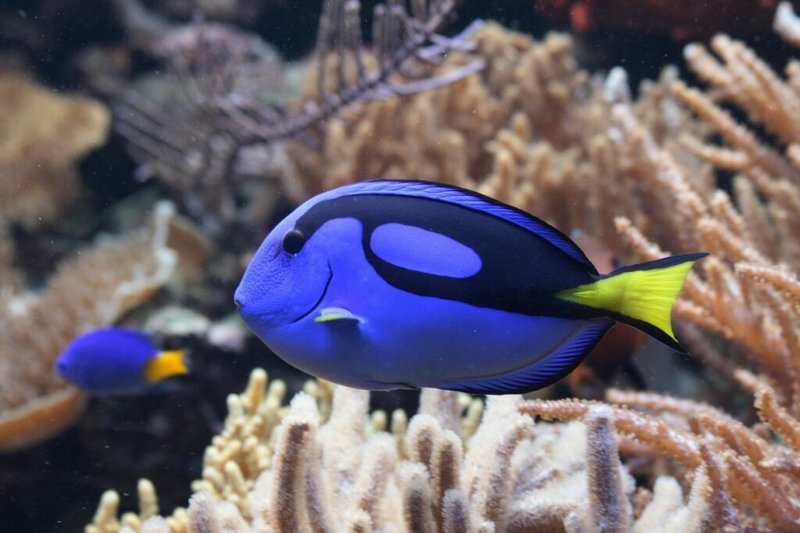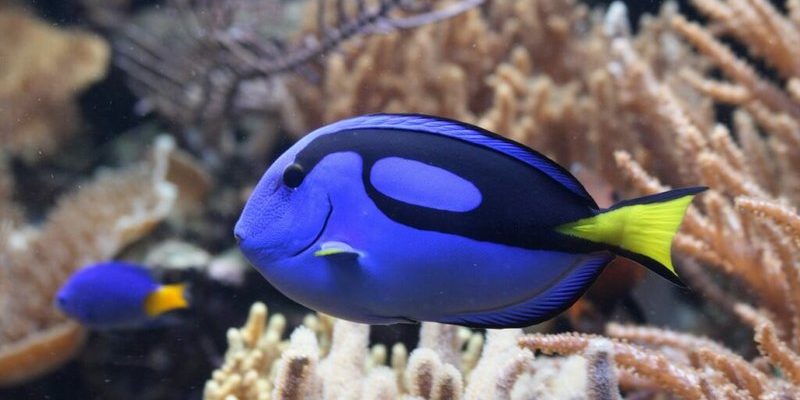
Picture it like hosting a dinner party. You wouldn’t invite just anyone to share a meal, right? You need to consider personalities, dietary needs, and even space. The same goes for your aquarium. Just because fish can technically live together doesn’t mean they will. In this article, we’re diving deep into Blue Tang tank mate compatibility to help you create a harmonious underwater community.
Understanding Blue Tang Behavior
Before we delve into tank mate compatibility, let’s take a closer look at the Blue Tang itself. Known scientifically as *Paracanthurus hepatus*, these fish are typically peaceful but can also display some territorial behavior. They’re like the fun-loving party guests who can also get a little cranky if their space is invaded.
Blue Tangs are known for their striking blue color and unique yellow tail. They love to swim around rocks and corals, so they need plenty of room to explore. In a way, you can think of them as the social butterflies of the aquarium world. They thrive in lively environments but can become stressed if kept with too many aggressive tank mates.
In terms of temperament, Blue Tangs are generally friendly, especially towards non-similar species. However, if you throw in other tangs or fish that look like them, you might see the more competitive side come out. So, understanding their personality is a key step towards picking suitable companions.
Ideal Tank Mates for Blue Tangs
When you’re on the lookout for fish to accompany your Blue Tang, it’s best to choose species that have a calm demeanor and won’t invade their territory. Here are some great options you can consider:
- Clownfish: These little guys are peaceful and add a nice splash of color. They can often be found hovering around anemones and won’t bother your Blue Tang.
- Butterflyfish: Known for their delicate features, butterflyfish are gentle swimmers that can coexist well with Blue Tangs.
- Cardinalfish: These small, community-oriented fish are perfect for a tank with Blue Tangs, as they tend to stick to their own kind and avoid conflict.
- Gobies: Tiny and playful, gobies can make excellent companions to a Blue Tang. They generally stay near the bottom and won’t interfere with the Blue Tang’s space.
Combining these species with your Blue Tang can create a lively, colorful environment that’s both visually appealing and peaceful. Just remember to keep an eye on interactions, especially when introducing new fish to the tank.
Fish to Avoid with Blue Tangs
While there are plenty of great options for tank mates, some fish are better left out of the equation. Here’s a list of species you should steer clear of if you want your Blue Tang to thrive peacefully:
- Other Tangs: It might seem logical to keep a bunch of tangs together, but they can quickly get territorial and aggressive.
- Angelfish: Some species of angelfish can be a bit nippy, which may lead to problems for your Blue Tang.
- Damselfish: These fish may seem harmless, but they can be quite aggressive, especially in smaller tanks.
- Sharks or larger predatory fish: Any fish that might see the Blue Tang as a snack should be avoided.
Being picky about your fishy friends can help create a peaceful and enjoyable environment for everyone involved. No one wants a tank full of drama!
Tank Size and Setup Considerations
Creating the right environment is crucial for the success of your Blue Tang and its tank mates. Generally, a minimum tank size of 75 gallons is recommended for Blue Tangs. They need plenty of swimming space and places to hide or feel secure, especially when they’re in a new environment.
When setting up your tank, make sure to include lots of live rock and hiding spots. This helps to mimic their natural habitat and gives your Blue Tang places to explore. Think of it like decorating your living room; you want it inviting but with plenty of cozy nooks.
Also, don’t forget about water quality! Blue Tangs are sensitive to changes in water chemistry. Make sure to provide a good filtration system and regularly test the water parameters. Clean water translates to happy fish, and happy fish are more likely to get along with their tank mates.
Introducing New Fish to the Aquarium
So, you’ve done all your research and are ready to add some new friends to the tank. That’s wonderful! However, introducing new fish needs to be done carefully to avoid any unwanted drama.
Start by quarantining new fish for about two weeks. This helps to protect your established tank from diseases. Afterward, when it’s time to introduce them, do it gradually. Turn off the tank light and use a net to gently transfer the new fish. This minimizes stress and allows everyone to adjust without feeling threatened.
You’ll also want to keep an eye on the interactions during the first few days. Some fish may need time to establish their roles, but if any aggression seems excessive, be ready to step in.
Understanding Signs of Stress and Aggression
It’s not uncommon for fish to experience stress when new tank mates are introduced or if they feel crowded. A stressed Blue Tang may display certain behaviors, such as hiding, darting around the tank, or even developing white spots, which can indicate disease.
If you notice these signs, it’s essential to act quickly. Check your water parameters, reduce overcrowding, or consider rearranging the tank decor to break any territorial disputes. Remember, a calm and balanced tank is crucial for everyone’s happiness!
Finding the right tank mates for your Blue Tang can feel a bit like matchmaking, but it’s definitely worth the effort. By carefully selecting compatible species, ensuring a spacious environment, and monitoring behavior, you can create a vibrant underwater community that will thrive together.
So, as you embark on this aquatic adventure, make sure to do your research, observe your fish, and remember that every tank is unique. With some patience and attention, you can ensure your Blue Tang and its new friends live happily ever after in their watery world!

